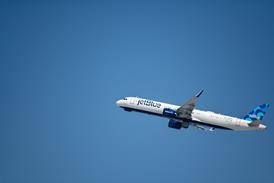Owners and operators of more than 2,300 US-registered Robinson R22- and R44-model helicopters must continue inspecting the outboard sections of the helicopter's metal main rotor skins for signs of debonding before each flight, a requirement that also applies to new factory models with modified blades.
The checks are part of an airworthiness directive (AD) issued by the US Federal Aviation Administration on 3 January, prompted by 11 reports of blade debonding, some of which occurred in flight and caused the pilot "to feel excessive vibrations", according to the FAA.
The AD also requires owners who have not completed earlier service bulletins issued by Robinson, calling for the pre-flight checks as well as a one-time detailed inspection, to perform a similar intensive survey within 10 hours time-in-service starting 18 January. That check includes a 10X magnification inspection of the skin-to-spar bond line on the lower surface of the blade, a "tap test" to detect skin-to-spar bond separation in the same area, and removal of both main rotor tip covers to check for corrosion or other issues that could cause debonding.
Kurt Robinson, vice-president of product support at Robinson Helicopter, says the company investigated the problem earlier and made changes to the metal blade manufacturing process, tightening the tolerance between the skin and spar and deepening the groove in the spar into which the skin is bonded.
The FAA however is not convinced the new blades will solve the problem, despite having no reports of debonding since the changes were introduced about a year ago. "It has not been proven that these changes will prevent a debond," the agency says in the AD. "Therefore, at this time, the FAA does not consider these newly manufactured blades to provide terminating action for the requirements of this AD."
Source: Flight International























